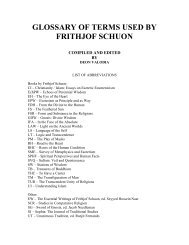Seyyed Hossein Nasr's - Sophia Perennis
Seyyed Hossein Nasr's - Sophia Perennis
Seyyed Hossein Nasr's - Sophia Perennis
You also want an ePaper? Increase the reach of your titles
YUMPU automatically turns print PDFs into web optimized ePapers that Google loves.
22As for the spiritual practices, it is no less clear that they are essentiallycontained in the inner core of the tradition, that is quintessential prayer:The Dhikr contains the whole Law (Shari’ah) and it is the reason for theexistence of the whole Law; 30 this is declared by the Koranic verse: “Verilyprayer (the exoteric practice) prevents man from committing what is shameful(sullying) and blameworthy; and verily the remembrance (invocation) of God(the esoteric practice) is greater. (Sura of the Spider, 45). 31 The formula “theremembrance of God is greater” or “the greatest thing” (Wa la-dhikru ‘Llahiakbar) evokes and paraphrases the following words from the Canonical Prayer:“God is greater” or “the greatest” (Allahu akbar) and this indicates a mysteriousconnection between God and His Name; it also indicates a certain relativity —from the point of view of gnosis — of the outward rites, which arenevertheless indispensable in principle and in the majority of cases. 32 In thisconnection we could also quote the following hadith: one of the Companionssaid to the Prophet: “0 Messenger of God, the prescriptions of Islam are toonumerous for me; tell me something that I can hold fast to.” The Prophetreplied: “Let thy tongue always be supple (in movement) with the mention (theremembrance) of God.” This hadith, like the verse we have just quoted,expresses by allusion (isharah) the principle of the inherence of the wholeShari’ah in the Dhikr alone. 33The concentration on quintessential prayer is both the ultimate limit of theinteriorizing and “deepening of the symbols of exoterism” –in so far as theDivine Name is the essence of the whole tradition-- and the supreme30 “ This is the point of view of all invocatory disciplines, such as the Hindu japa-yoga or theAmidist nembutsu (buddhanusmriti). This yoga is found in jnana as well as in bhakti: “Repeat theSacred Name of the Divinity,” said Shankaracharya in one of his hymns.” Ibid.31 “God and His Name are identical,” as Ramakrishna said; and he certainly was not the firstto say so.32 This reservation (“indispensable in principle and in the majority of cases”) does notcontradict the principle of “the inherence of the whole Sharî’ah in the Dhikr alone.” First, itapplies to the central rites of the religion and not necessarily to the whole host of traditionalpractices and juridical edicts that the tradition carries in its wake. Second, the expression “inprinciple” suggests the possibility of legitimate “facts” that would not conform to it. Thirdly,the reference to the “majority of cases” leaves room for exceptions and points to a collectivenorm and equilibrium rather than to an absolute spiritual necessity.33 Cf. Le Soufisme voile et quintessence, Paris, 1980, p.126.



